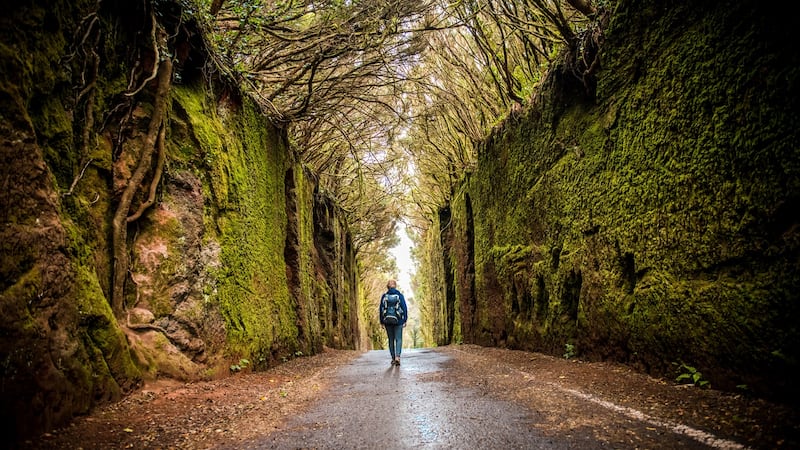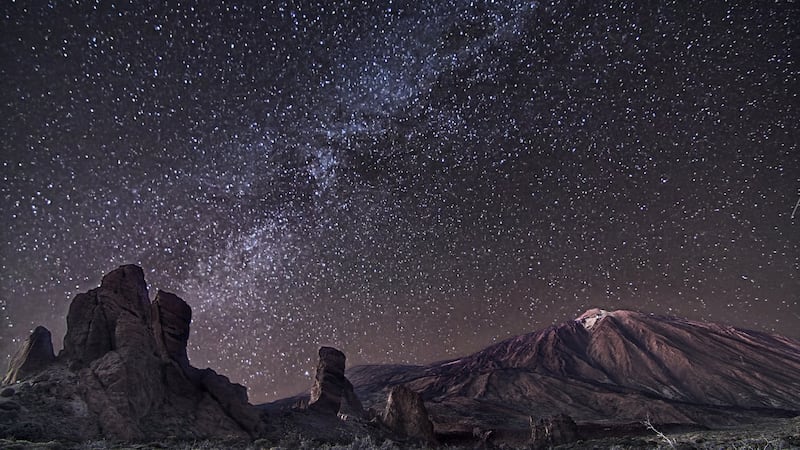Ever since I was a child, my happiest dreams are those in which I’m flying. Soaring high above the earth, the world seemed so exquisitely complete from the air – that state of in-between where struggle is oddly absent. It’s a sensation ever since resigned to that of my dream world. That is, until I run off the side of a 2,200m-high mountain in Tenerife. My only surprising reaction? The effortless connection to those dreams: the absence of fear, the depth of gratitude, the height of awe and wonder.
My first time paragliding is, as it turns out, one of several such boundary-pushing ventures in this outdoor activity El Dorado of the Canary Islands. Following one astounding half-hour (parapentecanarias.com, €120) with a middle-aged man strapped to my back, I make landfall in the northern coastal town of Puerto de la Cruz, watching surfers glide along industrial-scale breakers belched up from the Atlantic, before I head for a zaperoco (a multi-layered, Tenerife coffee liqueur) in the small town's 18th-century pedestrianised streets.
Getting about isn't the slightest hassle: this is a very clean, courteous and capable island, with careful drivers and fine roads
The largest and most populous of the Canarian archipelago, Tenerife revels in year-round, Mediterranean spring-like temperatures (ie gravitating to the low 20s), with sea temperatures between 17-24 degrees, making it a mecca for outdoor addicts.
While the south and south-east of the island can be, in broad brushstrokes, borderline tacky, most of Tenerife’s near-million citizens are located in the north. And that tells you enough.
That said, there’s a glut of must-dos across the south (including the airport for ex-Dublin flights), so go down there, milk it up and then return each afternoon/evening to the “real thing” further north; more authentic bases such as Puerto de la Cruz, La Orotava, La Laguna, Santa Cruz or even San Andrés.
Thus, a car rental is a necessity to scoot across the island, which stretches to about 80km. But getting about isn’t the slightest hassle: this is a very clean, courteous and capable island, with careful drivers and fine roads allowing you to travel the length of it in less than an hour.
If it's been too long since you last felt your jaw drop, then a morning down at Los Gigantes should settle that. On the southwestern coast of the island, these 400m-high calcified cliffs are truly awesome, and a two-hour, boat-assisted kayak at their feet may be the most memorable sea kayaking you ever experience (tenoactivo.com, €30).

Alternatively, meet at Teno Activo at the marina at Los Gigantes, be bussed up the craggy mountains to the eyrie-perched Guanche village of Mesca and then enjoy a three-hour guided hike down the arid, twisty canyon to the tiny pier, where you embark upon a boat-assisted, two-hour kayak home to the cafe-clad marina at Los Gigantes for a very reasonable €45 (or kayak and whale watch for €50). And I defy you to find better value for a day of such activities in such a stunning setting anywhere in Europe.
Anaga Experience (anagaexperience.com) is also a locally owned adventure company offering a similarly rousing suite of guided activities. But it's the rock climbing in Teide National Park (from €120) – piercing up into the heavens, it boasts of the highest mountain in "Spain", at 3,718m and the third-largest volcano in the world – that is the most memorable. Going up is the easy part, when the most you can "fall" is a few inches, but descending is oddly petrifying.
For ardent road cyclists, Tenerife is up there with Majorca as a well-serviced, mountainous, good-surfaced getaway
While there are endless hiking options, Anaga Experience also offers something a little more distinct in the gentle Tajinastes en Flor hike (€15-€25); a two- to three-hour sunset route, led by qualified local guides that tie in the park’s rare flora, fauna and geology with the island’s wider culture and history.
Unknown to me before my arrival, the isolation of these Canary Islands has allowed them to evolve not just predator-free – like some shrivelled New Zealand – but for more than 140 endemic flora to flourish. The forests near the centre are dominated by Canarian pine; charcoal-barked, centuries-old evergreens that are effectively fireproof.
Sprouting from spewed dry lava, these trees evolved with and through regular volcanic fires, whereby a month or so after being ostensibly burnt to a standstill, they spark back to life, like trick birthday cake candles.
Cycling
If e-biking off-road tracks tickle your fancy, then a blue-skied morning with locally owned Fun Bike Adventures (funbikeadventures.com) is a gentle option. The company offer five distinct guided off-road tours, but I go for the Tour Chinyero (€60 for three hours), weaving through boulder-clad pine forests to emerge out above the treeline into the Martian-like lava fields of El Chinyero, the 1,560m-high volcano that last erupted in 1909. Failing that, just hire an e-bike from them for about €35 a day and take to the hills.
For ardent road cyclists, Tenerife is up there with Majorca as a well-serviced, mountainous, good-surfaced getaway; so much so that the leading pro-teams station their training camps here for weeks on end.
In the south of the island, Free Motion (free-motion.com) in Los Cristianos offer guided routes ranging from 43km to more than 100km, with a daily elevation of 500m to 2,000+m, depending on your level. But if you prefer to simply rent the bike and go, it starts at about €24 per day.
For the northern half of the island, Teide Cycling (teidecycling.com) is based out of Puerto de la Cruz, with great road bikes for about €30 per day, but they also offer training camps and tours, as well as cycling coaching.
With Teide Cycling kindly dropping the bike to my accommodation, I start from sea-level, at the old harbour at Puerto de la Cruz one high-clouded morning, and eventually climb the full 2,300m to the highest road on all Spanish territory.
Like the rock climbing, it turns out that’s the easier part. Coming down through the clouds, though wrapped-up, I am frozen to the bone, shaking uncontrollably as I switchback through clouds. I stop at the first barrio, sink three hot chocolates and defrost my paws beneath the electric hand drier. All in all, it’s worth every shiver. Eventually.

Fresh air
But if all that sweaty palaver isn't for you, Tenerife still has plenty for the more passive fresh-air fan. The finer, sandy beaches do tend to be along the southern or most northern shores, and for €10, the beach bums among you can hardly beat a one-hour, guided introduction to stand-up paddle boarding (anagaexperience.com), meeting at the golden (imported Saharan) sands of Las Teresitas beach in the north-east of the island, where you will stay until the sun goes down.
Or you could do worse than three hours lounging on a sin-kissed catamaran (freebirdone.com, €35), sighting cetaceans off the southern coast. We see a couple of short-finned pilot whales within whispering distance and some free-wheeling dolphins. It's hardly world-beating, I know, but when you factor in the climate and catamaran, as well as complementary food and soft drinks, it's still good value for a morning at sea.
If, like Joxer in Juno and the Paycock, you ever wondered, "What is the stars?", then meet at Teide National Park at dusk any Friday and you will find out over the following three hours. El Cardón NaturExperience (elcardon.com, €30) will lead you on a gentle, guided hike about the caldera, whose 2,000m+ altitude allows for minimal light pollution.
As the guide delves into the realm of astronomy, tying in myth and legend with constellations, I wonder if the world for the stars seems as exquisitely complete from the air as it does for me in my dreams.
How to get there
Aer Lingus and Ryanair both fly into Tenerife’s southern airport, starting from about €40 each way.
Jamie Ball was a guest of Tenerife Tourism (webtenerife.com) and Turespana (spain.info/en)









